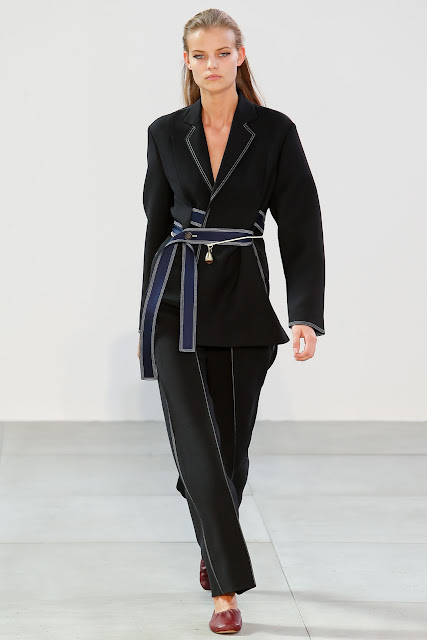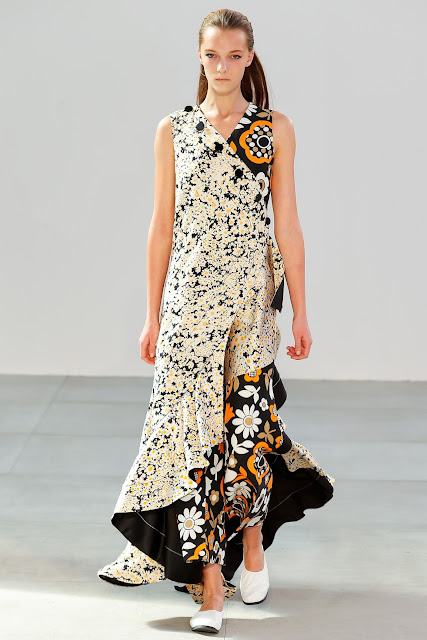THE “KIMONO’ INFLUNCE FOR SPRING 2016
The Designers seem to
be heavily influenced by the Kimono for Spring 2016. Love It!
The looks are chic, relaxed and casual… yet sophisticated. The construction of these garments allow us
to create our own looks; we could tie the loose jackets with the obi sash/belt,
or wear them unbelted, keeping the silhouette of the traditional Japanese knife
edged and cropped looks. The overall looks created by the Designers have a bit of a vintage yet modern touch;
there are no limits to the fabrication and/or patterns. We could create our very own looks with these garments. Let's take a look!!!
SandrienaKim (This Blog)
SandrienaKim (This Blog)
A model wears a creation by
Japanese rock star and kimono designer Yoshiki, left, at the YOSHIKIMONO first collection during the
finale of the Tokyo Fashion Week in Tokyo. Toshifumi Kitamura / AFP
Kimonos get a
makeover at Tokyo Fashion Week
Agence France-Presse
The traditional kimono was deconstructed and given an edgy,
rock ’n’ roll makeover on the last day of Tokyo Fashion Week
Tokyo fashion week drew
to a close at the weekend showcasing a new twist on the kimono, as the Japanese
classic makes a quiet comeback into women’s wardrobes.
In a departure from the
heavy silk usually used to make the traditional garb, designers are turning to
fabrics such as jersey, wool and even denim to reinvent the outfit.
“The kimono is fashion
... it shouldn’t be presented as old-fashioned,” says celebrated designer
Jotaro Saito.
“I want to spread the
message that kimono can be worn every day, it’s something people can wear like
they wear modern clothes, not something that makes them feel like they are in a
costume.”
Kimono, which translates
as “something to wear”, was originally a general term that covered a range of
garments worn by Japanese men and women for centuries, but has now come to
signify an outer robe tied with a wide sash known as an obi.
The kimono’s decline
dates back to the late 1800s when Japan’s rulers opened up the country to
modern influences after hundreds of years of self-imposed seclusion,
signalling a shift that would see future generations embrace western clothing.
The garment never quite
recovered its popularity, thanks to a prohibitively high cost that can run into
the thousands of dollars, compelling many brides to rent rather than purchase a
kimono for their weddings.
While kimono-clad women
are still a regular sight in major urban centres, the complicated garment tends
to be reserved for special occasions rather than daily use.
A key reason is that
wearers have to master a complex sequence of knots to tie the kimono tightly,
which intimidates many women into taking lessons for months or opting for
simpler western garb.
The downturn has
prompted government officials keen to preserve traditional culture to come up
with schemes such as Kyoto’s “kimono passport”, which gives wearers discounts
at stores and restaurants in the ancient capital.
But observers said the
fashion industry’s renewed interest may do more to ensure its survival.
Saito, born into a
family of kimono-dyeing artists in Kyoto, has worked with the garment for two
decades and believes change is critical to its future in fashion.
“What we need to do now
is evolve the kimono. We cannot just do what previous generations have already
done,” Saito says.
In a nod to
labour-intensive Japanese traditions, Saito’s kimonos – which can cost more
than one million yen (Dh30,728) – are all made by hand, from the dyeing stages
to stitching, printing and embroidery.
However, they showcase
innovative patterns and incorporate modern touches, such as fur-lined hoods,
while he uses a range of materials, from denim to silk.
In his debut showing on
Saturday night at fashion week, heavy-metal rocker Yoshiki collaborated with a
Kyoto-based brand on body-hugging kimonos, slashed to miniskirt-length and worn
with stilettos, leather collars and high-heeled boots.
The co-founder of the
band X Japan – who opened the show with a piano recital from Swan Lake –
used leopard-print fabric and gold netting in his designs. He says he wanted
to see women wear his kimonos to concerts: “I tried to combine rock’n’roll with
tradition,” he says.
The kimono’s many layers
and complex knots mean many women need to turn to classes or watch
instructional videos on YouTube.
“It’s ridiculous. There
is no need for so many rules ... Let’s make things simpler,” said Souta
Yamaguchi, a freelance fashion director who styles the kimono with urban street
wear in his work for retailers
Although purists
initially reacted to designers’ innovations with alarm, the tide has turned in
recent years, says Manami Okazaki, author of Kimono Now.
“Traditionalists were
very critical at first when they saw what designers were doing but now they
have realised that these modern versions can work as a bridge to attract
younger customers,” says Okazaki.
“The hope is that once
you introduce young people to kimonos made by contemporary designers, they will
eventually develop an interest in the traditional kimono, too.”
Yoshiki
Yoshikimono RTW Spring
2016
Tokyo Fashion Week decided to wrap up the spring 2016 action
with something a bit unusual: a runway show featuring kimonos designed by a
rock star. Fans — many of them screaming his name — packed the audience to see
Yoshiki, a member of the heavy metal band X Japan.
At the height of his music career in the
Nineties, Yoshiki was known for his elaborate stage costumes and makeup. His
current look is somewhat more toned down, but his love for theatrics was still
apparent in his runway show. After emerging wearing an open kimono over black
leather pants and a mesh top, Yoshiki revealed his face from behind a mask and
then walked over to a clear acrylic grand piano to perform. Other musicians on
stringed instruments and a traditional Japanese taiko drum rounded out his
ensemble.
For the most part, the kimonos themselves
were fairly standard, decorated with floral or butterfly motifs. There were
also some less conventional ones with geometric prints or leopard print trim.
Unlike the thicker silk of traditional garments, Yoshikimono’s were made from a
fine, slightly sheer fabric.
But where the kimonos most diverged from
tradition was in their sultry styling. Worn off the shoulder and folded up to
show plenty of leg, they were accessorized with lace lingerie, studded heels
and chokers, knee-high boots, and some very dangerous-looking hair sticks. The
show closed with the final model climbing atop Yoshiki’s piano as he played,
and striking a seductive pose under a single spotlight.
A spokesman for the company that makes the
kimonos said it will hold an exhibition later this month, with the hope of
getting the new kimono collection picked up by stores for next year.
Celine
Phoebe Philo
Designer/Creative Director of French fashion house Céline
Designer/Creative Director of French fashion house Céline
Celine
Sansai Saito
Kimono Designer
Jotaro Saito
Jotaro Saito was born in
Kyoto. Ever since his debut at the age of 27 as Japan's youngest kimono
designer, he offers a style that shares classic and contemporary sensibilities
,in the pursuit of creating Kimono as fashion that compliments contemporary
space. Currently, he promotes "a lifestyle of enjoying Japanese
taste," while producing interior and product designs.
Sansai Saito
ADEAM
Hanako
A Native Japanese, Hanako was born in Tokyo and moved to New York
City at the age of 5, spending most of her childhood there. She attended
Columbia University in the City of New York, and studied Anthropology and Art
History. While in college, Hanako partook in various fashion internships,
developing an undying love for fashion. In 2011, Hanako launched her own label
ADEAM with a capsule collection of 15 pieces. In March 2012, ADEAM was invited
by the Japanese government to present its Fall 2012 collection at Shanghai
Fashion Week. ADEAM showed its Spring 2013 collection at Tokyo Fashion Week,
and debuted at New York Fashion Week for Fall 2013. Inspired by her two
hometowns Tokyo and New York, Hanako continues to create collections that
infuse art and wearability.
ADEAM
ADEAM
Hanako
Marni
Consuelo Castiglioni
Marni is an Italian luxury fashion label founded by Consuelo Castiglioni in 1994, who remains as the label's designer.Marni
Fashion has two purposes:
comfort and love. Beauty comes when fashion
succeeds. -- Coco Chanel
Fashion is architecture. It
is a matter of proportions. -- Coco Chanel
Another great meeting
Fashionistas, let’s relax and take in the beauty of it all while we continue to
‘figure out the fashion trend’ meet again real soon. XOXO
Remember to click on
the ‘Older Posts’ button below to
research earlier posts.
































































































































































No comments:
Post a Comment